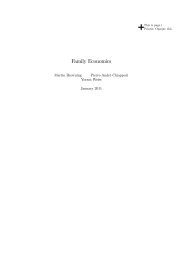Bounded Rationality in Industrial Organization
Bounded Rationality in Industrial Organization
Bounded Rationality in Industrial Organization
Create successful ePaper yourself
Turn your PDF publications into a flip-book with our unique Google optimized e-Paper software.
4.2 Computational complexity<br />
Explicit concern for computational complexity entered game theory at about the same<br />
time.<br />
Rub<strong>in</strong>ste<strong>in</strong> (1986) and Abreu and Rub<strong>in</strong>ste<strong>in</strong> (1988) discussed complexity <strong>in</strong> the<br />
context of repeated games. In particular, they discussed the concept of strategies’ be<strong>in</strong>g<br />
implementable by f<strong>in</strong>ite automata and used the number of states of an automaton as a<br />
measure of its complexity.<br />
Standard repeated game equilibria can be implemented by<br />
automata, but they note that a conundrum appears if one th<strong>in</strong>ks of agents as try<strong>in</strong>g both<br />
to maximize the payoffs they receive <strong>in</strong> the repeated game and to m<strong>in</strong>imize costs <strong>in</strong>herent<br />
<strong>in</strong> construct<strong>in</strong>g a more complex automata: agents will be tempted to leave off any states<br />
that are not reached on the equilibrium path and this may render the k<strong>in</strong>ds of off-path<br />
threats necessary to support cooperation <strong>in</strong>feasible.<br />
Fershtman and Kalai (1993) exam<strong>in</strong>e some IO questions us<strong>in</strong>g a similar complexity<br />
notion. They consider a multimarket monopoly and s<strong>in</strong>gle- and multimarket duopoly competition.<br />
Implicit <strong>in</strong> the complexity notion is a diseconomy of multimarket operation. If<br />
there are two possible states of demand <strong>in</strong> each market, then there are 2 n possible states<br />
for the n market comb<strong>in</strong>ation, and a fully optimiz<strong>in</strong>g monopolist would therefore need a<br />
plan with 2 n cont<strong>in</strong>gencies. They note that monopolists may want to avoid enter<strong>in</strong>g some<br />
markets to reduce complexity and discuss the complexity of dynamic collusion.<br />
The models of Rub<strong>in</strong>ste<strong>in</strong> (1993) and Piccione and Rub<strong>in</strong>ste<strong>in</strong> (2003) discussed below<br />
develop alternate approaches to complexity. Rub<strong>in</strong>ste<strong>in</strong> (1998) provides a nice survey of<br />
old and new work <strong>in</strong> this ve<strong>in</strong>.<br />
5 The New Behavioral IO: <strong>Bounded</strong> <strong>Rationality</strong> as Part of<br />
the IO Toolbox<br />
In the 1980’s it seems to have been extremely important that IO theory papers be fully<br />
rational. Today, be<strong>in</strong>g less that fully rational is much more acceptable. Indeed, I’d guess<br />
that at the top general <strong>in</strong>terest journals an IO paper now has a better chance of be<strong>in</strong>g<br />
14













